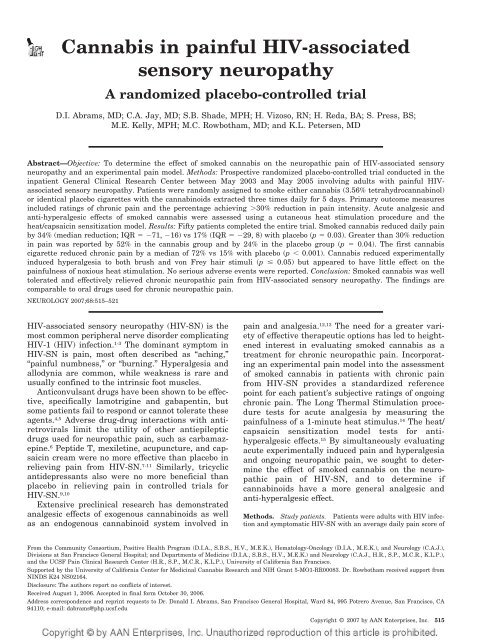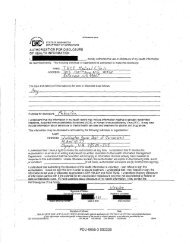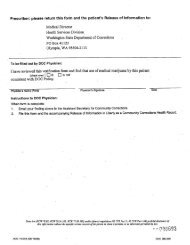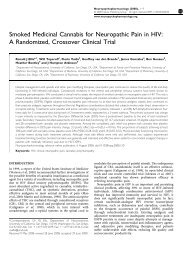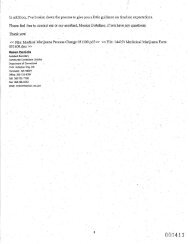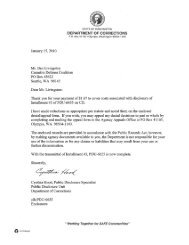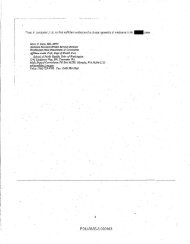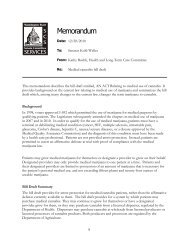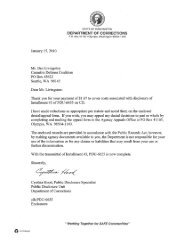Cannabis in painful HIV-associated sensory neuropathy
Cannabis in painful HIV-associated sensory neuropathy
Cannabis in painful HIV-associated sensory neuropathy
Create successful ePaper yourself
Turn your PDF publications into a flip-book with our unique Google optimized e-Paper software.
<strong>Cannabis</strong> <strong>in</strong> pa<strong>in</strong>ful <strong>HIV</strong>-<strong>associated</strong><strong>sensory</strong> <strong>neuropathy</strong>A randomized placebo-controlled trialD.I. Abrams, MD; C.A. Jay, MD; S.B. Shade, MPH; H. Vizoso, RN; H. Reda, BA; S. Press, BS;M.E. Kelly, MPH; M.C. Rowbotham, MD; and K.L. Petersen, MDAbstract—Objective: To determ<strong>in</strong>e the effect of smoked cannabis on the neuropathic pa<strong>in</strong> of <strong>HIV</strong>-<strong>associated</strong> <strong>sensory</strong><strong>neuropathy</strong> and an experimental pa<strong>in</strong> model. Methods: Prospective randomized placebo-controlled trial conducted <strong>in</strong> the<strong>in</strong>patient General Cl<strong>in</strong>ical Research Center between May 2003 and May 2005 <strong>in</strong>volv<strong>in</strong>g adults with pa<strong>in</strong>ful <strong>HIV</strong><strong>associated</strong><strong>sensory</strong> <strong>neuropathy</strong>. Patients were randomly assigned to smoke either cannabis (3.56% tetrahydrocannab<strong>in</strong>ol)or identical placebo cigarettes with the cannab<strong>in</strong>oids extracted three times daily for 5 days. Primary outcome measures<strong>in</strong>cluded rat<strong>in</strong>gs of chronic pa<strong>in</strong> and the percentage achiev<strong>in</strong>g 30% reduction <strong>in</strong> pa<strong>in</strong> <strong>in</strong>tensity. Acute analgesic andanti-hyperalgesic effects of smoked cannabis were assessed us<strong>in</strong>g a cutaneous heat stimulation procedure and theheat/capsaic<strong>in</strong> sensitization model. Results: Fifty patients completed the entire trial. Smoked cannabis reduced daily pa<strong>in</strong>by 34% (median reduction; IQR 71, 16) vs 17% (IQR 29, 8) with placebo (p 0.03). Greater than 30% reduction<strong>in</strong> pa<strong>in</strong> was reported by 52% <strong>in</strong> the cannabis group and by 24% <strong>in</strong> the placebo group (p 0.04). The first cannabiscigarette reduced chronic pa<strong>in</strong> by a median of 72% vs 15% with placebo (p 0.001). <strong>Cannabis</strong> reduced experimentally<strong>in</strong>duced hyperalgesia to both brush and von Frey hair stimuli (p 0.05) but appeared to have little effect on thepa<strong>in</strong>fulness of noxious heat stimulation. No serious adverse events were reported. Conclusion: Smoked cannabis was welltolerated and effectively relieved chronic neuropathic pa<strong>in</strong> from <strong>HIV</strong>-<strong>associated</strong> <strong>sensory</strong> <strong>neuropathy</strong>. The f<strong>in</strong>d<strong>in</strong>gs arecomparable to oral drugs used for chronic neuropathic pa<strong>in</strong>.NEUROLOGY 2007;68:515–521<strong>HIV</strong>-<strong>associated</strong> <strong>sensory</strong> <strong>neuropathy</strong> (<strong>HIV</strong>-SN) is themost common peripheral nerve disorder complicat<strong>in</strong>g<strong>HIV</strong>-1 (<strong>HIV</strong>) <strong>in</strong>fection. 1-3 The dom<strong>in</strong>ant symptom <strong>in</strong><strong>HIV</strong>-SN is pa<strong>in</strong>, most often described as “ach<strong>in</strong>g,”“pa<strong>in</strong>ful numbness,” or “burn<strong>in</strong>g.” Hyperalgesia andallodynia are common, while weakness is rare andusually conf<strong>in</strong>ed to the <strong>in</strong>tr<strong>in</strong>sic foot muscles.Anticonvulsant drugs have been shown to be effective,specifically lamotrig<strong>in</strong>e and gabapent<strong>in</strong>, butsome patients fail to respond or cannot tolerate theseagents. 4,5 Adverse drug-drug <strong>in</strong>teractions with antiretroviralslimit the utility of other antiepilepticdrugs used for neuropathic pa<strong>in</strong>, such as carbamazep<strong>in</strong>e.6 Peptide T, mexilet<strong>in</strong>e, acupuncture, and capsaic<strong>in</strong>cream were no more effective than placebo <strong>in</strong>reliev<strong>in</strong>g pa<strong>in</strong> from <strong>HIV</strong>-SN. 7-11 Similarly, tricyclicantidepressants also were no more beneficial thanplacebo <strong>in</strong> reliev<strong>in</strong>g pa<strong>in</strong> <strong>in</strong> controlled trials for<strong>HIV</strong>-SN. 9,10Extensive precl<strong>in</strong>ical research has demonstratedanalgesic effects of exogenous cannab<strong>in</strong>oids as wellas an endogenous cannab<strong>in</strong>oid system <strong>in</strong>volved <strong>in</strong>pa<strong>in</strong> and analgesia. 12,13 The need for a greater varietyof effective therapeutic options has led to heightened<strong>in</strong>terest <strong>in</strong> evaluat<strong>in</strong>g smoked cannabis as atreatment for chronic neuropathic pa<strong>in</strong>. Incorporat<strong>in</strong>gan experimental pa<strong>in</strong> model <strong>in</strong>to the assessmentof smoked cannabis <strong>in</strong> patients with chronic pa<strong>in</strong>from <strong>HIV</strong>-SN provides a standardized referencepo<strong>in</strong>t for each patient’s subjective rat<strong>in</strong>gs of ongo<strong>in</strong>gchronic pa<strong>in</strong>. The Long Thermal Stimulation proceduretests for acute analgesia by measur<strong>in</strong>g thepa<strong>in</strong>fulness of a 1-m<strong>in</strong>ute heat stimulus. 14 The heat/capsaic<strong>in</strong> sensitization model tests for antihyperalgesiceffects. 15 By simultaneously evaluat<strong>in</strong>gacute experimentally <strong>in</strong>duced pa<strong>in</strong> and hyperalgesiaand ongo<strong>in</strong>g neuropathic pa<strong>in</strong>, we sought to determ<strong>in</strong>ethe effect of smoked cannabis on the neuropathicpa<strong>in</strong> of <strong>HIV</strong>-SN, and to determ<strong>in</strong>e ifcannab<strong>in</strong>oids have a more general analgesic andanti-hyperalgesic effect.Methods. Study patients. Patients were adults with <strong>HIV</strong> <strong>in</strong>fectionand symptomatic <strong>HIV</strong>-SN with an average daily pa<strong>in</strong> score ofFrom the Community Consortium, Positive Health Program (D.I.A., S.B.S., H.V., M.E.K.), Hematology-Oncology (D.I.A., M.E.K.), and Neurology (C.A.J.),Divisions at San Francisco General Hospital; and Departments of Medic<strong>in</strong>e (D.I.A., S.B.S., H.V., M.E.K.) and Neurology (C.A.J., H.R., S.P., M.C.R., K.L.P.),and the UCSF Pa<strong>in</strong> Cl<strong>in</strong>ical Research Center (H.R., S.P., M.C.R., K.L.P.), University of California San Francisco.Supported by the University of California Center for Medic<strong>in</strong>al <strong>Cannabis</strong> Research and NIH Grant 5-MO1-RR00083. Dr. Rowbotham received support fromNINDS K24 NS02164.Disclosure: The authors report no conflicts of <strong>in</strong>terest.Received August 1, 2006. Accepted <strong>in</strong> f<strong>in</strong>al form October 30, 2006.Address correspondence and repr<strong>in</strong>t requests to Dr. Donald I. Abrams, San Francisco General Hospital, Ward 84, 995 Potrero Avenue, San Francisco, CA94110; e-mail: dabrams@php.ucsf.eduCopyright © 2007 by AAN Enterprises, Inc. 515
Figure 1. Timel<strong>in</strong>e of procedures <strong>associated</strong>with first and last smok<strong>in</strong>g sessions(day 1 and day 5) and illustrationof mark<strong>in</strong>g of borders of hyperalgesiaon the forearm surround<strong>in</strong>g the stimulatedarea. Procedures: LTS longthermal stimulation—upper arm (45 °Cfor 1 m<strong>in</strong>ute); forearm heat: 45 °C for 5m<strong>in</strong>utes; forearm capsaic<strong>in</strong>: 0.075% for30 m<strong>in</strong>utes; VAS Visual AnalogScale—Rat<strong>in</strong>g of current neuropathicpa<strong>in</strong>; map map area of secondaryhyperalgesia (brush and von Frey);RK rek<strong>in</strong>dl<strong>in</strong>g—forearm (40 °C for5 m<strong>in</strong>utes).at least 30 mm on the 100 mm visual analog scale dur<strong>in</strong>g theoutpatient pre-<strong>in</strong>tervention phase. Patients were <strong>in</strong> stable health,were without current substance abuse (<strong>in</strong>clud<strong>in</strong>g tobacco), andfollowed a stable medication regimen for pa<strong>in</strong> and <strong>HIV</strong> for at least8 weeks prior to enrollment. Pa<strong>in</strong>ful <strong>HIV</strong>-SN was confirmed bysymptoms of symmetric distal pa<strong>in</strong> or dysesthesias <strong>in</strong> the lowerextremities for at least 2 weeks, comb<strong>in</strong>ed with absent or depressedankle reflexes or <strong>sensory</strong> loss of vibration, p<strong>in</strong>, temperature,or touch on exam<strong>in</strong>ation by the study neurologist (C.A.J.). Afamily history of poly<strong>neuropathy</strong>, <strong>neuropathy</strong> due to causes otherthan <strong>HIV</strong> or dideoxynucleosides, and use of isoniazid, dapsone, ormetronidazole with<strong>in</strong> 8 weeks prior to enrollment were exclusionary.<strong>HIV</strong> <strong>neuropathy</strong> was def<strong>in</strong>ed as onset of symptoms withoutconcomitant dideoxynucleoside antiretroviral therapy and nucleoside<strong>neuropathy</strong> as symptom onset dur<strong>in</strong>g dideoxynucleosidetreatment. Subjects with <strong>HIV</strong> <strong>neuropathy</strong> whose symptoms worsenedon dideoxynucleoside agents were considered to have both<strong>HIV</strong> and nucleoside <strong>neuropathy</strong>.All patients were required to have prior experience smok<strong>in</strong>gcannabis (def<strong>in</strong>ed as six or more times <strong>in</strong> their lifetime), so thatthey would know how to <strong>in</strong>hale and what neuropsychologic effectsto expect. Current users were asked to discont<strong>in</strong>ue any cannabisuse prior to study admission.The study was approved by the Institutional Review Board atthe University of California San Francisco, the Research AdvisoryPanel of California, the Drug Enforcement Adm<strong>in</strong>istration, theFood and Drug Adm<strong>in</strong>istration, and the National Institute onDrug Abuse. Written <strong>in</strong>formed consent was obta<strong>in</strong>ed from all patients.The trial was monitored by an <strong>in</strong>dependent Data SafetyMonitor<strong>in</strong>g Board (DSMB) established by the University of CaliforniaCenter for Medic<strong>in</strong>al <strong>Cannabis</strong> Research.Study medication. The National Institute on Drug Abuse providedidentically appear<strong>in</strong>g pre-rolled cannabis and placebo cigarettesweigh<strong>in</strong>g on average 0.9 g. Active cannabis cigarettesconta<strong>in</strong>ed 3.56% delta-9-tetrahydrocannab<strong>in</strong>ol (delta-9-THC), andidentical-appear<strong>in</strong>g placebo cannabis cigarettes from which theactive components had been extracted conta<strong>in</strong>ed 0% delta-9-THC.The cigarettes were kept <strong>in</strong> a locked and alarmed freezer untilthey were dispensed to a locked freezer <strong>in</strong> the San FranciscoGeneral Hospital General Cl<strong>in</strong>ical Research Center where the<strong>in</strong>patient study was conducted. The frozen cigarettes were rehydratedovernight <strong>in</strong> a humidifier. Patients were housed <strong>in</strong> a roomwith a fan ventilat<strong>in</strong>g to the outside. Research staff monitoredpatients dur<strong>in</strong>g smok<strong>in</strong>g sessions, weighed the cannabis cigarettesimmediately before and after they were adm<strong>in</strong>istered to patients,and returned all leftover material to the pharmacy. To maximizestandardization of <strong>in</strong>haled doses, patients followed a uniform puffprocedure. 16Study timel<strong>in</strong>e and procedures. The study had four phases: a7-day outpatient pre-<strong>in</strong>tervention phase (study days –9 to –3) toestablish eligibility; a 2-day <strong>in</strong>patient lead-<strong>in</strong> phase (study days –2and –1) <strong>in</strong> which patients were acclimated to the <strong>in</strong>patient GeneralCl<strong>in</strong>ical Research Center sett<strong>in</strong>g and basel<strong>in</strong>e measurementswere obta<strong>in</strong>ed; a 5-day <strong>in</strong>patient <strong>in</strong>tervention phase (study days 1to 5); and a 7-day outpatient post-<strong>in</strong>tervention phase (study days 6to 12) dur<strong>in</strong>g which patients cont<strong>in</strong>ued to record pa<strong>in</strong> rat<strong>in</strong>gs eachday.Randomization (1:1) to cannabis or placebo cigarettes wascomputer-generated by the study statistician and managed by an<strong>in</strong>dependent research pharmacist. Treatment was double-bl<strong>in</strong>d.After hospital admission on day –2, patients were not allowed toleave the hospital or receive visitors. Patients smoked their firstcigarette at 2 PM on day 1, and their last cigarette at 2 PM on day5. Pa<strong>in</strong> model procedures and repeated rat<strong>in</strong>gs of chronic pa<strong>in</strong>were <strong>in</strong>corporated <strong>in</strong>to the first and last smok<strong>in</strong>g session, asshown <strong>in</strong> figure 1. On the <strong>in</strong>terven<strong>in</strong>g study days, patientssmoked, as tolerated, one cigarette three times daily (8:00 AM, 2:00PM, 8:00 PM). Preadmission analgesics were cont<strong>in</strong>ued throughoutthe study.Primary outcome measure: Daily diary pa<strong>in</strong> VAS. Beg<strong>in</strong>n<strong>in</strong>gwith the outpatient pre-<strong>in</strong>tervention phase and extend<strong>in</strong>g throughthe post-<strong>in</strong>tervention phase, patients completed a diary at 8 AMeach morn<strong>in</strong>g to rate their chronic neuropathic pa<strong>in</strong> dur<strong>in</strong>g thepreced<strong>in</strong>g 24 hours on a 100 mm visual analog scale (VAS) labeled“no pa<strong>in</strong>” at 0 mm and “worst pa<strong>in</strong> imag<strong>in</strong>able” at 100 mm.Secondary outcome measures: Day 1 and day 5 smok<strong>in</strong>g sessions.Rat<strong>in</strong>gs of chronic neuropathic pa<strong>in</strong> VAS. To assess the immediateeffect of smoked cannabis on chronic neuropathic pa<strong>in</strong>, patientsrated their current pa<strong>in</strong> at 40-m<strong>in</strong>ute <strong>in</strong>tervals three timesbefore and three times after smok<strong>in</strong>g the first and last cigaretteon a 100-mm VAS (figure 1). In the pilot study, we observed rapid<strong>in</strong>creases <strong>in</strong> plasma levels of delta-9 THC after 2 m<strong>in</strong>utes (mean 96.8 ng/mL; 95% CI 48.7, 145.0) with rapid decl<strong>in</strong>es after 1hour (mean 6.2 ng/mL; 95% CI 3.3, 9.2). This study wasdesigned so these measures were collected with<strong>in</strong> the time of peakplasma levels.LTS procedure. The long thermal stimulation procedure(LTS) was used to assess acute analgesic effects. Sk<strong>in</strong> on thenon-dom<strong>in</strong>ant shoulder was heated us<strong>in</strong>g a computer-controlledPeltier device with a 15.7-cm 2 surface area thermode (TSA 2001,Medoc, Israel). 17,18 The probe is held aga<strong>in</strong>st the sk<strong>in</strong> at a hold<strong>in</strong>gtemperature of 32 °C and then heated to 45 °C at a l<strong>in</strong>ear rate. Onreach<strong>in</strong>g 45 °C, pa<strong>in</strong> is then rated cont<strong>in</strong>uously us<strong>in</strong>g an electronicvisual analog scale with a 100-mm l<strong>in</strong>ear track for 1 m<strong>in</strong>ute beforethermode removal. The LTS procedure was performed twice beforeand three times after smok<strong>in</strong>g.Heat/capsaic<strong>in</strong> sensitization model. The heat/capsaic<strong>in</strong> sensitizationmodel was used to assess anti-hyperalgesic effects by<strong>in</strong>duc<strong>in</strong>g neuronal sensitization sufficient to produce an area ofcutaneous secondary hyperalgesia that can be mapped andquantified. 14,15,17-19 Heat/capsaic<strong>in</strong> sensitization was <strong>in</strong>duced on a22.8 cm 2 stimulation site on the forearm by us<strong>in</strong>g the thermode toheat the sk<strong>in</strong> to 45 °C for 5 m<strong>in</strong>utes followed by treat<strong>in</strong>g thestimulation site with topical capsaic<strong>in</strong> cream (0.075%, Capzais<strong>in</strong>HP, Chattem Inc.; Chattanooga, TN) for 30 m<strong>in</strong>utes. Cutaneoushyperalgesia was ma<strong>in</strong>ta<strong>in</strong>ed by heat<strong>in</strong>g the stimulation site to 40°C for 5 m<strong>in</strong>utes (rek<strong>in</strong>dl<strong>in</strong>g procedure) at 40-m<strong>in</strong>ute <strong>in</strong>tervals.After each rek<strong>in</strong>dl<strong>in</strong>g, areas of secondary hyperalgesia were quantifiedwith a 1-<strong>in</strong>ch foam brush and with a 26-g von Frey hair (amildly noxious p<strong>in</strong>-like sensation) by stimulat<strong>in</strong>g along l<strong>in</strong>ear rostral–caudaland lateral–medial paths around the stimulation site<strong>in</strong> 5-mm steps at 1-second <strong>in</strong>tervals. Start<strong>in</strong>g well outside thehyperalgesic area and cont<strong>in</strong>u<strong>in</strong>g toward the treated sk<strong>in</strong> area,the sk<strong>in</strong> was marked where patients reported a def<strong>in</strong>ite change <strong>in</strong>516 NEUROLOGY 68 February 13, 2007
sensation (such as burn<strong>in</strong>g, tenderness, or more <strong>in</strong>tense prick<strong>in</strong>g).The distances from the center of the stimulation site were thenmeasured and surface area calculated. The first (basel<strong>in</strong>e) rek<strong>in</strong>dl<strong>in</strong>gwas performed before smok<strong>in</strong>g and rek<strong>in</strong>dl<strong>in</strong>g was repeatedthree times after smok<strong>in</strong>g.Safety, side effects, and mood rat<strong>in</strong>gs. On study days –1, 2,and 5, patients completed the Profile of Mood States to assesstotal mood disturbance and subscales of tension-anxiety,depression-dejection, anger-hostility, vigor-activity, fatigue<strong>in</strong>ertia,and confusion-bewilderment. 20 Side effects of anxiety, sedation,disorientation, paranoia, confusion, dizz<strong>in</strong>ess, and nauseawere patient-rated on a 0 to 3 scale (none, mild, moderate, severe)at 9:00 AM, 3:00 PM, and 9:00 PM dur<strong>in</strong>g the entire hospital stay.Adverse events were graded us<strong>in</strong>g the NIH Division of AIDS tablefor grad<strong>in</strong>g severity of adult adverse experiences. 21Statistical analysis. Study sample size was based on an openlabelpilot trial <strong>in</strong> 16 patients with <strong>HIV</strong>-SN of very similar design.22 The mean reduction <strong>in</strong> pa<strong>in</strong> was 30.1% (95% CI: 61.2,1.0). Ten pilot patients (62%) had a greater than 30% decrease <strong>in</strong>their daily pa<strong>in</strong>, the prespecified criterion of cl<strong>in</strong>ically mean<strong>in</strong>gfulpa<strong>in</strong> relief. 23 Apply<strong>in</strong>g the same variances to a randomized,placebo-controlled trial and conservatively estimat<strong>in</strong>g that 50% ofcannabis patients and 13% of placebo patients would meet the30% pa<strong>in</strong> reduction criterion yields a sample size of 48 patientswith an alpha of 0.05 and a beta of 0.20.Statistical analyses were conducted on a modified <strong>in</strong>tent-totreat(ITT) sample. All patients who rema<strong>in</strong>ed <strong>in</strong> the study at eachtime po<strong>in</strong>t were <strong>in</strong>cluded <strong>in</strong> the analyses. The primary outcomewas the proportion of patients <strong>in</strong> the cannabis and placebo groupswho experienced at least a 30% reduction <strong>in</strong> daily diary pa<strong>in</strong> levelfrom basel<strong>in</strong>e (average of the two daily diary pa<strong>in</strong> levels rated at 8AM on study day 1 and study day 1) to end-of-treatment (averageof study days 4 and 5). p Values were obta<strong>in</strong>ed us<strong>in</strong>g 2 test for 2by 2 tables.The co-primary outcome variable was the percent change <strong>in</strong>pa<strong>in</strong> from basel<strong>in</strong>e. Percent change <strong>in</strong> each group was not normallydistributed; therefore, the nonparametric Mann-Whitneytest was used to compare percent change <strong>in</strong> pa<strong>in</strong> across studygroups. Pa<strong>in</strong> reduction was also modeled as a function of groupand time us<strong>in</strong>g a repeated measures model (generalized estimat<strong>in</strong>gequations). All available patient <strong>in</strong>formation, <strong>in</strong>clud<strong>in</strong>g <strong>in</strong>formationon patients who later withdrew from the study, was<strong>in</strong>cluded <strong>in</strong> this model. The data were fitted us<strong>in</strong>g time squared toallow for non-l<strong>in</strong>earity <strong>in</strong> the relationship between group andtime. To adjust for potentially confound<strong>in</strong>g patient characteristics,we controlled for age, gender, pre-study ongo<strong>in</strong>g use of cannabis(yes or no), cause of <strong>neuropathy</strong>, and basel<strong>in</strong>e daily pa<strong>in</strong>.Secondary outcome variables collected while smok<strong>in</strong>g the firstcigarette on day 1 and the last cigarette on day 5 consisted ofpercent change (relative to pre-smok<strong>in</strong>g basel<strong>in</strong>e for that session)<strong>in</strong> 100 mm VAS rat<strong>in</strong>gs of chronic neuropathic pa<strong>in</strong>, pa<strong>in</strong>fulnessof the LTS procedure, and areas of secondary hyperalgesia producedby the heat/capsaic<strong>in</strong> sensitization model to brush and vonFrey hair stimuli. For each of these repeated measures, the areaunder the curve (AUC) for percent change <strong>in</strong> pa<strong>in</strong> or area ofsensitization was computed relative to pre-smok<strong>in</strong>g basel<strong>in</strong>e values(or the average of the pre-smok<strong>in</strong>g values if multiple measurementswere available). The total AUC was standardized asaverage percent change per hour by divid<strong>in</strong>g each AUC by 60.Differences <strong>in</strong> AUC were compared us<strong>in</strong>g Mann-Whitney tests asthese data were not normally distributed.Additional secondary outcome analyses of the percent change<strong>in</strong> total mood disturbance and percent change <strong>in</strong> the six subscalesof the Profile of Mood States was analyzed us<strong>in</strong>g <strong>in</strong>dependent ttests or Mann-Whitney tests if the data were not normally distributed.Side effect rat<strong>in</strong>gs were compared us<strong>in</strong>g repeated measuresmodels (generalized estimat<strong>in</strong>g equations), us<strong>in</strong>g a negative b<strong>in</strong>omialdistribution to allow for rare events and over-dispersed dataand adjusted for differences <strong>in</strong> mean recorded side effects acrossstudy days and time of day of measurement.Role of the fund<strong>in</strong>g source. The University of California Centerfor Medic<strong>in</strong>al <strong>Cannabis</strong> Research provided assistance with obta<strong>in</strong><strong>in</strong>gnecessary regulatory approvals, data quality monitor<strong>in</strong>g,and establish<strong>in</strong>g the study’s Data Safety Monitor<strong>in</strong>g Board.Results. Study patients. A total of 223 patients wereassessed for eligibility between May 2003 and May 2005Figure 2. Flow of participants through the trial.(figure 2) and 55 <strong>in</strong>dividuals were enrolled. Of these, 27were randomized to cannabis cigarettes and 28 were randomizedto placebo cigarettes. One patient withdrew dur<strong>in</strong>gthe <strong>in</strong>patient <strong>in</strong>tervention phase prior to smok<strong>in</strong>g thefirst cigarette, and four additional patients withdrew priorto completion of the <strong>in</strong>patient phase, leav<strong>in</strong>g 25 patients <strong>in</strong>each group who completed the entire study. All smok<strong>in</strong>gsessions were observed by research staff and completed perprotocol.Thirty randomized patients completed the experimentalpa<strong>in</strong> model portion of the study (14 cannabis, 16 placebo).Of the 25 patients who did not fully participate <strong>in</strong> thisportion of the study, 17 could not tolerate the pa<strong>in</strong>ful stimulationwhen tested dur<strong>in</strong>g the outpatient pre-<strong>in</strong>terventionphase, one developed a blister, one discont<strong>in</strong>ued prior tostudy day 1, and six did not meet eligibility criteria for thepa<strong>in</strong> model portion (extensive tattoo<strong>in</strong>g <strong>in</strong> one and heatpa<strong>in</strong> detection threshold above 47 °C <strong>in</strong> five).The patients randomized to cannabis and placebo cigaretteswere similar with regard to demographic and basel<strong>in</strong>echaracteristics (table 1). Patients were predom<strong>in</strong>antlymen with 14 years of <strong>HIV</strong> <strong>in</strong>fection and 7 years of peripheral<strong>neuropathy</strong>. Neuropathy was believed to be secondaryto antiretroviral medications <strong>in</strong> the majority of patients <strong>in</strong>both groups. Over half of patients <strong>in</strong> each group used concomitantmedications for pa<strong>in</strong>, with about one quarter ofeach group us<strong>in</strong>g more than one type of concomitant medication.The most frequently used concomitant medicationwas gabapent<strong>in</strong> (15 patients) followed by opioids (14patients).Primary outcome measure. Median daily pa<strong>in</strong> rat<strong>in</strong>gsfor the two groups throughout the entire study are shown<strong>in</strong> figure 3. Basel<strong>in</strong>e (average of day 1 and day 1) dailydiary pa<strong>in</strong> rat<strong>in</strong>gs were similar (cannabis median 52, <strong>in</strong>terquartilerange [IQR] 38, 71; placebo median 57,IQR 40, 74). Among those who completed the study, 13of 25 patients randomized to cannabis cigarettes had30% reduction <strong>in</strong> pa<strong>in</strong> from basel<strong>in</strong>e to end of treatmentvs 6 of 25 patients receiv<strong>in</strong>g placebo cigarettes (52% vs24%; difference 28%, 95% CI 2% to 54%, p 0.04). Themedian reduction <strong>in</strong> chronic neuropathic pa<strong>in</strong> on the dailydiary VAS was 34% (IQR 71, 16) <strong>in</strong> the cannabisgroup and 17% <strong>in</strong> the placebo group (IQR 29, 8; difference 18%; p 0.03, Mann-Whitney test). In the multivariablerepeated measures model, which analyzedavailable data from all randomized patients, the estimatedgroup difference was slightly larger than the observed dif-February 13, 2007 NEUROLOGY 68 517
Table 1 Patient characteristicsSex, n (%)* <strong>Cannabis</strong> (n 27) Placebo (n 28)Male 22 (81) 26 (93)Female 5 (19) 2 (7)Age, y, mean SD 50 6 47 7Race/ethnicity, n (%)White 14 (52) 11 (39)African American 9 (33) 12 (43)Lat<strong>in</strong>o 3 (11) 5 (18)Asian/Pacific Islander 1 (4) 0Duration of <strong>HIV</strong>, y, mean SD 15 4 14 5On HAART, n (%) 18 (67) 24 (86)CD4 T lymphocyte (cells/mm 3 ), median (IQR) 355 (250, 536) 444 (311, 523)Viral load, n (%)400 19 (70) 17 (61)400 8 (30) 11 (39)Duration of <strong>neuropathy</strong>, y, median (IQR) 7 (3, 9) 7 (3, 9)Cause of <strong>neuropathy</strong>, n (%)<strong>HIV</strong> 10 (37) 7 (25)Nucleosides 12 (44) 14 (50)Both 5 (19) 7 (25)Intensity of pa<strong>in</strong> at basel<strong>in</strong>e (0–100), mean SD 53 20 54 23Current cannabis use, n (%)Yes 21 (78) 19 (68)No 6 (22) 9 (32)Concomitant medications, n (%) 15 (56) 16 (57)Types of concomitant medications, n (%)†Gabapent<strong>in</strong> 7 (26) 7 (25)Opioid 5 (19) 8 (29)Other medication 9 (33) 10 (36)Multiple concomitant medications, n (%) 6 (22) 7 (25)* Male to female transgender for 1 cannabis and 2 placebo patients.† Multiple responses possible.ference among those who completed the study (26%; 95%CI 0, 51; p 0.05).Secondary outcome measures. Smok<strong>in</strong>g the first cannabiscigarette reduced chronic pa<strong>in</strong> rat<strong>in</strong>gs (AUC) by amedian of 72% vs a reduction of 15% with placebo cigarettes(p 0.001, Mann-Whitney test; figure 4A). On day 5just prior to smok<strong>in</strong>g the last cigarette, median rat<strong>in</strong>gs ofcurrent chronic pa<strong>in</strong> <strong>in</strong>tensity were lower <strong>in</strong> the cannabisgroup (15; IQR 7, 34) than <strong>in</strong> the placebo group (29; IQR 20, 60; p 0.006, Mann-Whitney test). Smok<strong>in</strong>g thelast cigarette further reduced chronic pa<strong>in</strong> rat<strong>in</strong>gs 51%<strong>in</strong> the cannabis group vs 5% <strong>in</strong> the placebo group(p 0.001, Mann-Whitney test).In the 30 patients who underwent the pa<strong>in</strong> model portionof the study, LTS (a measure of acute analgesia tonoxious heat stimuli) did not appear to be substantiallyreduced by smok<strong>in</strong>g the first cigarette on day 1 <strong>in</strong> eithergroup (figure 4B, median 22% for cannabis and 5%for placebo; p 0.31). Areas of experimental heat/capsaic<strong>in</strong>secondary hyperalgesia on the forearm were similar <strong>in</strong>518 NEUROLOGY 68 February 13, 2007the two groups prior to smok<strong>in</strong>g the first cigarette. Activecannabis reduced the area to both brush and von Frey hairstimuli compared to placebo (median 34% vs 11%;p 0.05 and 52% vs 3%; p 0.05; figure 4, C and D).Smok<strong>in</strong>g the last cigarette on day 5 did not alter the pa<strong>in</strong>fulnessof the LTS procedure or reduce the areas of secondaryhyperalgesia <strong>in</strong> either group.Safety and mood effects of cannabis. No patient withdrewfrom the study because of adverse events. One episodeof grade 3 dizz<strong>in</strong>ess related to study medicationoccurred <strong>in</strong> the cannabis group. One case of transientgrade 3 anxiety possibly related to study medication wasreported <strong>in</strong> each group. Both patients received a one-timedose of lorazepam. No other patients required psychotropicmedications for treatment of dysphoric effects. No episodesof hypertension, hypotension, or tachycardia requir<strong>in</strong>gmedical <strong>in</strong>tervention occurred.Mean recorded side effects were low <strong>in</strong> both studygroups. However, side effects rat<strong>in</strong>gs were higher <strong>in</strong> patients<strong>in</strong> the cannabis group, as shown <strong>in</strong> table 2, for anx-
Table 2 Mean side effect scores by study groupAdjusted estimates<strong>Cannabis</strong>, mean(95% CI)Placebo, mean(95% CI)Anxiety* 0.25 (0.14, 0.44) 0.10 (0.05, 0.22)Sedation† 0.54 (0.36, 0.81) 0.08 (0.04, 0.17)Disorientation† 0.16 (0.07, 0.34) 0.01 (0.00, 0.04)Paranoia 0.13 (0.03, 0.45) 0.04 (0.01, 0.14)Confusion† 0.17 (0.07, 0.39) 0.01 (0.00, 0.06)Dizz<strong>in</strong>ess† 0.15 (0.07, 0.31) 0.02 (0.01, 0.05)Nausea 0.11 (0.04, 0.30) 0.03 (0.01, 0.14)Figure 3. Time course of the <strong>in</strong>tensity of chronic neuropathicpa<strong>in</strong> as rated on the daily diary VAS at 8 AM forthe previous 24-hour period. Each po<strong>in</strong>t represents thegroup median. Study admission was at noon on study day–2, the first cigarette was smoked at 2 PM on study day 1,and the last cigarette was smoked at 2 PM on study day 5.iety (p 0.04), sedation (p 0.001), disorientation (p 0.001), confusion (p 0.001), and dizz<strong>in</strong>ess (p 0.001).Although these differences were significant, the values forboth groups hovered closer to zero than one and do notrepresent any serious safety concerns <strong>in</strong> this short-termstudy. The Profile of Mood States <strong>in</strong>dicated a reduction <strong>in</strong>total mood disturbance dur<strong>in</strong>g the 5 days of smok<strong>in</strong>g (median33% cannabis vs 29% placebo; p 0.28). Althoughall subscale scores decl<strong>in</strong>ed <strong>in</strong> both groups, the only differencewas a larger decrease <strong>in</strong> depression-dejection <strong>in</strong> theplacebo group (median 63% cannabis vs 76% placebo;p 0.05, Mann-Whitney test).Discussion. Over a 5-day <strong>in</strong>patient <strong>in</strong>terventionperiod, smok<strong>in</strong>g cannabis cigarettes three times aFigure 4. First smok<strong>in</strong>g session: time course dur<strong>in</strong>g thefirst 95 m<strong>in</strong>utes after smok<strong>in</strong>g of <strong>in</strong>tensity of chronic pa<strong>in</strong>as measured on the visual analog scale (A; cannabis n 25, placebo n 25), pa<strong>in</strong>fulness of LTS (B; cannabis n 14, placebo n 16), and areas of secondary hyperalgesiato brush and von Frey hair stimulation (C and D; cannabisn 14, placebo n 16). Mean 95% CI.Side effects were rated three times daily on a 0 to 3 scale (0 none, 1 mild, 2 moderate, 3 severe).* p, 0.05; † p 0.001.day reduced <strong>HIV</strong>-SN pa<strong>in</strong> by 34%, significantly morethan the 17% reduction with placebo cigarettes. A30% reduction <strong>in</strong> pa<strong>in</strong> has been validated as a cl<strong>in</strong>icallysignificant level of improvement. 23 In the currentstudy, half (52%) of those randomized tocannabis experienced at least a 30% reduction <strong>in</strong>pa<strong>in</strong>, while a quarter (24%) of those randomized toplacebo experienced a similar reduction <strong>in</strong> pa<strong>in</strong>.In this randomized, placebo-controlled study, thenumber needed to treat (NNT) on the primary outcomemeasure of 30% pa<strong>in</strong> reduction among allcomplet<strong>in</strong>g patients was 3.6 (1/[52%24%]). Trialsvary <strong>in</strong> their primary outcome measure, so compar<strong>in</strong>gNNT figures only approximates relative potency.The NNT for lamotrig<strong>in</strong>e was 5.4 for <strong>HIV</strong>-relatedpa<strong>in</strong>ful DSP. 4,24 Although one group of <strong>in</strong>vestigatorsreported success with gabapent<strong>in</strong>, their data analysisdoes not allow calculation of an NNT. 5 The NNT<strong>in</strong> the present study is comparable to that reported<strong>in</strong> trials of gabapent<strong>in</strong> for other types of chronic neuropathicpa<strong>in</strong>. In a large study of gabapent<strong>in</strong> forpostherpetic neuralgia the NNT was 3.4 and for diabetic<strong>neuropathy</strong> the NNT was 4.0. 25,26 A recentmeta-analysis of 107 controlled trials for neuropathicpa<strong>in</strong> showed that only tricyclic antidepressants andhigher potency opioids consistently achieved NNTvalues lower than 3.7. 24 However, for <strong>HIV</strong>-SN, tricyclicantidepressants were not effective. 9,10 Opioidshave not been systematically evaluated for pa<strong>in</strong>ful<strong>HIV</strong>-SN, but studies show efficacy across a broadspectrum of neuropathic pa<strong>in</strong> disorders. 27,28In addition to patient-reported changes <strong>in</strong> ongo<strong>in</strong>gchronic pa<strong>in</strong>, smoked cannabis attenuated the cutaneoushyperalgesia <strong>associated</strong> with central neuronalsensitization produced by a standardized experimentalpa<strong>in</strong> model. Although one cannot entirely excludepa<strong>in</strong> relief due to relaxation, a high, or unbl<strong>in</strong>d<strong>in</strong>g,the mood effects recorded argue aga<strong>in</strong>st such an explanation.Only one of the six Profile of Mood Statessubscales (depression-dejection) showed a significantgroup difference, and actually favored placebo. Moreover,rat<strong>in</strong>gs of side effects <strong>in</strong> the cannabis groupFebruary 13, 2007 NEUROLOGY 68 519
were low. The rigorous experimental pa<strong>in</strong> model outcomemeasures are novel to each patient and notstrongly <strong>associated</strong> with expectations of relief ofchronic pa<strong>in</strong>. Areas of secondary hyperalgesia aremapped by an <strong>in</strong>vestigator while the patient looksaway, and thus may be less subjective than pa<strong>in</strong><strong>in</strong>tensity rat<strong>in</strong>gs on a VAS scale. Therefore, thepresent study provides evidence that cannabis hasanalgesic effects on acute central neuronal sensitizationproduced by the experimental pa<strong>in</strong> model aswell as on the neuronal mechanisms <strong>associated</strong> withpa<strong>in</strong>ful <strong>HIV</strong>-SN.The results reported here <strong>in</strong> neuropathic pa<strong>in</strong> patientsexposed to an experimental pa<strong>in</strong> model areconsistent with precl<strong>in</strong>ical pa<strong>in</strong> model studies withcannab<strong>in</strong>oids. Systemic cannab<strong>in</strong>oids are effective <strong>in</strong>animal models of acute mechanical and thermalpa<strong>in</strong>, <strong>in</strong>flammation and hyperalgesia, and nerve<strong>in</strong>jury. 29-35 In healthy human volunteers, smokedcannabis <strong>in</strong>creased pressure pa<strong>in</strong> tolerance thresholds.36 The present study <strong>in</strong> chronic pa<strong>in</strong> patientsalso shows an effect on experimental hyperalgesia.Although smoked cannabis did not appear to suppressthe pa<strong>in</strong>fulness of the LTS procedure (analogousto the hot plate or tail flick test <strong>in</strong> animals),this may reflect the relatively low concentration ofdelta-9-THC <strong>in</strong> the study cigarettes.The cl<strong>in</strong>ical literature on cannab<strong>in</strong>oids for pa<strong>in</strong>conditions other than <strong>HIV</strong>-SN is limited and essentiallyrestricted to isolated delta-9-THC preparations.Fifteen and 20 mg of delta-9-THC producedsignificant analgesia <strong>in</strong> cancer patients with pa<strong>in</strong>, aswell as antiemesis and appetite stimulation, butsome patients reported unwanted side effects such assedation and depersonalization at the 20 mg doselevel. 37,38 In a follow-up study, 10 mg of delta-9-THCproduced analgesic effects comparable to 60 mg ofcode<strong>in</strong>e, and 20 mg of delta-9-THC was equivalent to120 mg of code<strong>in</strong>e. Two recent placebo-controlledstudies of cannab<strong>in</strong>oids for central neuropathic pa<strong>in</strong><strong>associated</strong> with multiple sclerosis produced resultssimilar to the present study. In a crossover trial ofsynthetic delta-9-THC up to 10 mg/day, an NNT of3.5 was reported. 39 A trial of a subl<strong>in</strong>gual spray conta<strong>in</strong><strong>in</strong>gdelta-9-THC alone or comb<strong>in</strong>ed with cannabidiolshowed a 41% pa<strong>in</strong> reduction with active drugvs a 22% reduction with placebo. 40The Institute of Medic<strong>in</strong>e report on cannabis andmedic<strong>in</strong>e concluded that cannab<strong>in</strong>oids likely have anatural role <strong>in</strong> pa<strong>in</strong> modulation, control of movement,and memory. 41 The Institute of Medic<strong>in</strong>e report,along with other recent reviews, suggest that ifcannabis compounds can be shown to have therapeuticvalue then the marg<strong>in</strong> of safety is acceptable. 42,43An acceptable safety marg<strong>in</strong> has been shown <strong>in</strong> thepresent study as well as <strong>in</strong> a previous study of cannab<strong>in</strong>oids<strong>in</strong> patients with <strong>HIV</strong>-1 <strong>in</strong>fection. 44AcknowledgmentThe authors thank study participants; the General Cl<strong>in</strong>ical ResearchCenter nurs<strong>in</strong>g staff; Sheila Huang, PharmD; Jessica Possehnand Marlene Berro from the Pa<strong>in</strong> Cl<strong>in</strong>ical Research Center;Joan Hilton, DSc, and Peter Bacchetti, PhD, at the UCSF Departmentof Biostatistics and Epidemiology; and Heather Bentley atthe University of California Center for Medic<strong>in</strong>al <strong>Cannabis</strong> Researchfor her assistance with regulatory affairs, data qualitymanagement, and <strong>in</strong>teraction with the Data Safety Monitor<strong>in</strong>gBoard.References1. So YT, Holtzman DM, Abrams DI, Olney RK. Peripheral <strong>neuropathy</strong><strong>associated</strong> with acquired immunodeficiency syndrome. Arch Neurol1988;45:945–948.2. Sacktor N. The epidemiology of human immunodeficiency virus<strong>associated</strong>neurological disease <strong>in</strong> the era of highly active retroviraltherapy. J Neurovirol 2002;8(suppl 2):115–121.3. McArthur JC, Brew BJ, Nath A. Neurological complications of <strong>HIV</strong><strong>in</strong>fection. Lancet Neurol 2005;4:543–555.4. Simpson DM, McArthur JC, Olney R, et al. Lamotrig<strong>in</strong>e for <strong>HIV</strong><strong>associated</strong>pa<strong>in</strong>ful <strong>sensory</strong> neuropathies: a placebo-controlled trial.Neurology 2003;60:1508–1514.5. Hahn K, Arendt G, Braun JS. A placebo-controlled trial of gabapent<strong>in</strong>for pa<strong>in</strong>ful <strong>HIV</strong>-<strong>associated</strong> <strong>sensory</strong> neuropathies. J Neurol 2004;251:1260–1266.6. Hugen PW, Burger DM, Br<strong>in</strong>kman K, et al. Carbamazep<strong>in</strong>e-<strong>in</strong>d<strong>in</strong>avir<strong>in</strong>teraction causes antiretroviral therapy failure. Ann Pharmacother2000;34:465–470.7. Simpson DM, Dorfman D, Olney RK, et al. Peptide T <strong>in</strong> the treatmentof pa<strong>in</strong>ful distal <strong>neuropathy</strong> <strong>associated</strong> with AIDS: results of a placebocontrolledtrial. Neurology 1996;47:1254–1259.8. Kemper CA, Kent G, Burton S, Deres<strong>in</strong>ski SC. Mexilet<strong>in</strong>e for <strong>HIV</strong><strong>in</strong>fectedpatients with pa<strong>in</strong>ful peripheral <strong>neuropathy</strong>: a double-bl<strong>in</strong>d,placebo-controlled, crossover treatment trial. J Acquir Immune DeficSyndr Hum Retrovirol 1998;19:367–372.9. Keiburtz K, Simpson D, Yiannoutsos C, et al. A randomized trial ofamitriptyl<strong>in</strong>e and mexilet<strong>in</strong>e for pa<strong>in</strong>ful <strong>neuropathy</strong> <strong>in</strong> <strong>HIV</strong> <strong>in</strong>fection.Neurology 1998;51:1682–1688.10. Shlay JC, Chaloner K, Max MG, et al. Acupuncture and amitriptyl<strong>in</strong>efor pa<strong>in</strong> due to <strong>HIV</strong>-related peripheral <strong>neuropathy</strong>: a randomized cl<strong>in</strong>icaltrial. JAMA 1998;280:1590–1595.11. Paice JA, Ferrans CE, Lashley FR, Shott S, Vizgirda V, Pitrak D.Topical capsaic<strong>in</strong> <strong>in</strong> the management of <strong>HIV</strong>-<strong>associated</strong> peripheral <strong>neuropathy</strong>.J Pa<strong>in</strong> Symptom Manage 2000;19:45–52.12. Calignano A, LaRana G, Giuffrida A, Piomelli D. Control of pa<strong>in</strong> <strong>in</strong>itiationby endogenous cannab<strong>in</strong>oids. Nature 1998;394:277–281.13. Walker JM, Huang SM. Cannab<strong>in</strong>oid analgesia. Pharmacol Ther 2002;95:127–135.14. Petersen KL, Maloney A, Hoke F, Dahl JB, Rowbotham MC. A randomizedstudy of the effect of oral lamotrig<strong>in</strong>e and hydromorphone on pa<strong>in</strong>and hyperalgesia follow<strong>in</strong>g heat/capsaic<strong>in</strong> sensitization. J Pa<strong>in</strong> 2003;4:400–406.15. Petersen KL, Rowbotham MC. A new human experimental pa<strong>in</strong> model:the heat/capsaic<strong>in</strong> sensitization model. Neuroreport 1999;10:1511–1516.16. Folt<strong>in</strong> RW, Fischman MW, Byrne MF. Effects of smoked cannabis onfood <strong>in</strong>take and body weight of humans liv<strong>in</strong>g <strong>in</strong> a residential laboratory.Appetite 1988;25:577–582.17. Petersen KL, Jones B, Segredo V, Dahl JB, Rowbotham MC. Effect ofremifentanil on pa<strong>in</strong> and secondary hyperalgesia <strong>associated</strong> with theheat-capsaic<strong>in</strong> sensitization model <strong>in</strong> healthy volunteers. Anesthesiology2001;94:15–20.18. Dirks J, Petersen KL, Rowbotham MC, Dahl JB. Gabapent<strong>in</strong> suppressescutaneous hyperalgesia follow<strong>in</strong>g heat/capsaic<strong>in</strong> sensitization.Anesthesiology 2002;97:102–107.19. Dirks K, Petersen KL, Dahl JB. The heat capsaic<strong>in</strong> sensitization model:a methodological study. J Pa<strong>in</strong> 2003;4:122–128.20. McNair DM, Lorr M, Droppleman LF. Manual for the Profile of MoodStates (POMS). San Diego: Educational and Industrial Test<strong>in</strong>g Service,1971.21. NIH Division of AIDS Table for Grad<strong>in</strong>g Severity of Adult AdverseExperiences, August 1992. Available at: http://rcc.tech-res-<strong>in</strong>tl.com/tox_tables.htm. Accessed March 6, 2006.22. Jay C, Shade S, Vizoso H, et al. The effect of smoked cannabis onchronic neuropathic and experimentally-<strong>in</strong>duced pa<strong>in</strong> <strong>in</strong> <strong>HIV</strong> <strong>neuropathy</strong>:results of an open-label pilot study. 11th Conference on Retrovirusesand Opportunistic Infections 2004: abstract 496:243.23. Farrar JT, Young JP Jr, LaMoreaux L, Werth JL, Poole RM. Cl<strong>in</strong>icalimportance of changes <strong>in</strong> chronic pa<strong>in</strong> <strong>in</strong>tensity measured on an 11-po<strong>in</strong>t numerical pa<strong>in</strong> rat<strong>in</strong>g scale. Pa<strong>in</strong> 2001;94:149–158.24. F<strong>in</strong>nerup NB, Otto M, McQuay HJ, Jensen TS, S<strong>in</strong>drup SH. Algorithmfor neuropathic pa<strong>in</strong> treatment: an evidence based proposal. Pa<strong>in</strong> 2005;118:289–305.25. Rowbotham M, Harden N, Stacey B, Bernste<strong>in</strong> P, Magnus-Miller L.Gabapent<strong>in</strong> for the treatment of postherpetic neuralgia: a randomizedcontrolled trial. JAMA 1998;280:1837–1842.520 NEUROLOGY 68 February 13, 2007
26. Backonja M, Beydoun A, Edwards KR, et al. Gabapent<strong>in</strong> for the symptomatictreatment of pa<strong>in</strong>ful <strong>neuropathy</strong> <strong>in</strong> patients with diabetes mellitus:a randomized controlled trial. JAMA 1998;280:1831–1836.27. Rowbotham MC, Twill<strong>in</strong>g L, Davies PS, Reisner L, Taylor K, Mohr D.Oral opioid therapy for chronic peripheral and central neuropathicpa<strong>in</strong>. N Engl J Med 2003;348:1223–1232.28. Eisenberg E, McNichol ED, Carr DB. Efficacy and safety of opioidagonists <strong>in</strong> the treatment of neuropathic pa<strong>in</strong> of nonmalignant orig<strong>in</strong>:Systematic review and meta-analysis of randomized controlled trials.JAMA 2005;293:3043–3052.29. Grunfeld Y, Edery H. Psychopharmacological activity of the active constituentsof hashish and some related cannab<strong>in</strong>oids. Psychopharmacologia1969;14:200–210.30. Buxbaum DM. Analgesic activity of 9 -tetrahydrocannab<strong>in</strong>ol <strong>in</strong> the ratand mouse. Psychopharmacologia 1972;25:275–280.31. Chesher GB, Dahl CJ, Ever<strong>in</strong>gham M, Jackson DM, Marchant-Williams H, Starmer GA. The effect of cannab<strong>in</strong>oids on <strong>in</strong>test<strong>in</strong>al motilityand their ant<strong>in</strong>ociceptive effect <strong>in</strong> mice. Br J Pharmacol 1973;49:588–594.32. Sofia RD, Vassar HB, Nalepa SD. Correlations between pathologicalchanges <strong>in</strong> the h<strong>in</strong>d paws of rats with adjuvant arthritis and theirresponse to anti-<strong>in</strong>flammatory and analgesic drugs. Eur J Pharmacol1973;24:108–112.33. Moss DE, Johnson RL. Tonic analgesic effects of delta9-tetrahydrocannab<strong>in</strong>ol as measured with the formal<strong>in</strong> test. EurJ Pharmacol 1980;61:313–315.34. Li J, Daughters RS, Bullis C, et al. The cannab<strong>in</strong>oid receptor agonistWIN 55,212-2 mesylate blocks the development of hyperalgesia producedby capsaic<strong>in</strong> <strong>in</strong> rats. Pa<strong>in</strong> 1999;81:25–33.35. Herzberg U, Eliav E, Bennett GJ, Kop<strong>in</strong> IJ. The analgesic effect ofR()-WIN 55,212-2 mesylate, a high aff<strong>in</strong>ity cannab<strong>in</strong>oid agonist, <strong>in</strong> arat model of neuropathic pa<strong>in</strong>. Neurosci Lett 1997;221:157–160.36. Milste<strong>in</strong> SL, MacCannell K, Karr G, Clark S. <strong>Cannabis</strong>-producedchanges <strong>in</strong> pa<strong>in</strong> tolerance. Experienced and non-experienced subjects.Int Pharmacopsychiatry 1975;10:177–182.37. Noyes R Jr, Baram DA. <strong>Cannabis</strong> analgesia. Compr Psychiatry 1974;15:531–535.38. Noyes R, Brunk S, Avery D, Canter A. The analgesic properties ofdelta-9-tertrahydrocannab<strong>in</strong>ol and code<strong>in</strong>e. Cl<strong>in</strong> Pharmacol Ther 1975;18:84–89.39. Svendsen KB, Jensen TS, Back FW. Does the cannab<strong>in</strong>oid dronab<strong>in</strong>olreduce central pa<strong>in</strong> <strong>in</strong> multiple sclerosis? Randomised double bl<strong>in</strong>dplacebo controlled crossover trial. BMJ 2004;329:253–260.40. Rog DJ, Nurmikko TJ, Fride T, Young CA. Randomized, controlled trialof cannabis-based medic<strong>in</strong>e <strong>in</strong> central pa<strong>in</strong> <strong>in</strong> multiple sclerosis. Neurology2005;65:812–819.41. Joy J, Watson S, Bensen J. <strong>Cannabis</strong> and medic<strong>in</strong>e: assess<strong>in</strong>g thescience base. Wash<strong>in</strong>gton, DC: National Academy Press; 1999. Availableat: http://www.nap.edu42. Attal N, Brasseur L, Guirimand D, Clermond-Gnamien S, Atlamis S,Bouhassira D. Are oral cannab<strong>in</strong>oids safe and effective <strong>in</strong> refractoryneuropathic pa<strong>in</strong>? Eur J Pa<strong>in</strong> 2004;8:173–177.43. Woolridge E, Barton S, Samuel J, Osorio J, Dougherty A, Holdcroft A.<strong>Cannabis</strong> use <strong>in</strong> <strong>HIV</strong> for pa<strong>in</strong> and other medical symptoms. J Pa<strong>in</strong>Symptom Manage 2005;29:358–367.44. Abrams DI, Hilton JF, Leiser RJ, et al. Short-term effects of cannab<strong>in</strong>oids<strong>in</strong> patients with <strong>HIV</strong>-1 <strong>in</strong>fection: a randomized, placebo-controlledcl<strong>in</strong>ical trial Ann Intern Med 2003;139:258–299.UPDATE YOUR PRACTICE IN A WEEKEND ATANNUAL MEETINGGa<strong>in</strong> the tools you need to update your practice dur<strong>in</strong>g the first weekend at the Annual Meet<strong>in</strong>g. Attend the newPractice Colloquium on pay-for-performance and negotiat<strong>in</strong>g with payers, the Patient Safety Colloquium, and theBRAINS Colloquium for practice managers. Stay until Monday and attend the Guidel<strong>in</strong>es, Practice, and AdvocacyOpen House. All are free to registered attendees. Supplement this knowledge with Saturday’s full-day practice managementcourse (1FC.001) or half-day course on us<strong>in</strong>g guidel<strong>in</strong>es and evidence <strong>in</strong> daily practice (1PC.002). Visitam.aan.com/other/advocacy.cfm for dates and times.PREORDER ANNUAL MEETING PRODUCTS AND SAVEPurchase your AAN 2007 Virtual Annual Meet<strong>in</strong>g products now and save! Save up to $80 on the 2007 Syllabi onCD-ROM and up to $100 on Webcasts-on-Demand, with onl<strong>in</strong>e access to the slides, audio, and video of more than 240hours of programs and presentations, <strong>in</strong>clud<strong>in</strong>g all five plenary sessions. Order with your meet<strong>in</strong>g registration atam.aan.com.February 13, 2007 NEUROLOGY 68 521


